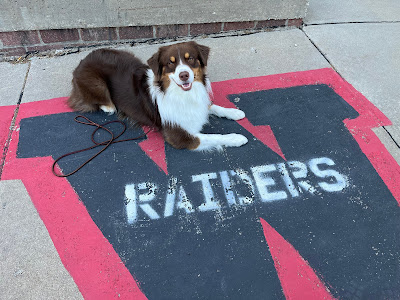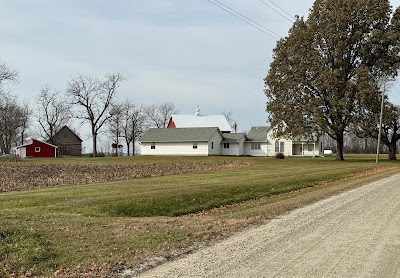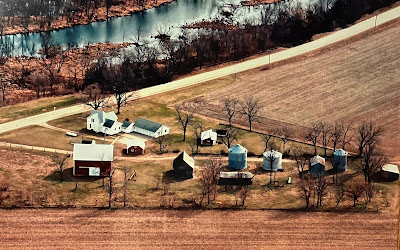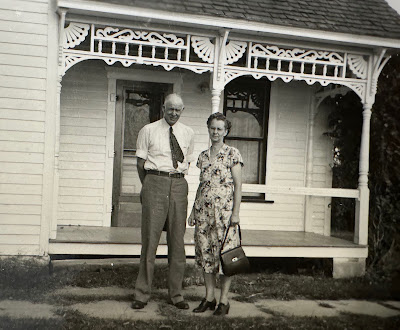In a nutshell, 2023 was six months of desperation followed by two months of sweat and exhaustion, ending with wondering what day it was and trying to exorcise the demons that demanded I be frantically busy from morning to night.
The new year started by doubling down on cleaning out Mom’s house (hereafter known as The House), following her passing in late 2022. I didn’t have an end game in sight beyond a vague notion of a sale at some point. I literally couldn’t think beyond the immediate need to sort through the accumulation of six decades that filled each room. And the garages, barn, chicken house, granary and machine shed. They say nothing will make you a minimalist faster than having to clean out your parents’ house. They are right.
Also, the ancient furnace at The House went out. Multiple times. My immersion into being an absentee landlord (even for a vacant house) was not a kind and gentle one. I had the local plumbing and heating service on speed dial. January involved a lot of coffee.
And there was a tornado in Iowa County. A freaking tornado in January. Guess who took this photo? It was not me. I was in the basement with the dogs, like any good NWS-trained storm spotter who is not interested in doing an intercept on her back porch, which was exactly where that thing was headed until it had the good sense to lift about a mile southwest of our house. It was rated an EF0 or EF1 but still managed to tear up some neighbors’ trees and buildings and flip a semi on Interstate 80.
February was a 28-day repeat of January, including the coffee and furnace issues at The House but minus the tornado.
In March, Banner threw up a nail. I have no idea why he ate a nail in the first place. It is further proof this dog would survive the zombie apocalypse. He would eat the zombies before they ate him.
March brought another round of wild weather, with a severe thunderstorm that did a number on our trees and farm buildings. The storm also left a spectacular display of mammatus clouds in its wake. This delighted me because until then, I’d only seen mammatus while watching reruns of “Storm Chasers.”
Things started to get a little twitchy with my job in the spring. The shine had gone off the new publisher’s promises to make everything sparkly and golden in my ragged little newspaper kingdom. Opinions were voiced. Things were said. I was handed a fifth paper to run, in addition to the four I was already struggling to keep afloat as the sole full-time editor/reporter/photographer and chief mugwump.
April was a blur. I went to dog shows and kept cleaning out The House. I also made a Big Decision.
May brought a trip to USASA nationals, a delightful escape from reality, confirming my decision to follow the meme and build a life I didn’t need to escape from.
I came home from nationals and quit my job. I’d been running the papers solo since 2019, with a few dedicated stringers who kept me from totally losing my mind but it was clear the corporate cavalry was never going to send reinforcements. I was burned out, stressed out, up to my eyeballs in dealing with The House and my parents’ farm, being executor for Mom’s estate and acting as care advocate for my aunt in a care center. I was living on iced coffee and Mt. Dew. This was not a sustainable life plan.
I smiled as I walked out of the office for the last time. No regrets. Zero ducks to give.
Summer was a whirlwind of cleaning and decisions at The House. What to keep? What to sell? What is this worth? What IS this?
I brought home a few special pieces and let the rest go. One of the best discoveries was this flower garden quilt, hand-pieced by my grandma Hanson, who died before I was born.
One of the more memorable achievements of The House’s clean-out was orchestrating the move of a walnut blanket chest handmade by my grandfather down the suicide stairs from the second floor. The Farmer said it wouldn’t fit. I said it would. The chest was 27 inches wide. The staircase was 27.5 inches wide. I was careful not to point out who was right because I needed the person who was wrong to help move the thing. The move was accomplished without getting 911 involved and both the Farmer and my bro-in-law are still speaking to me.
The end was in sight. We hauled over a ton of junk to the landfill. Wonderful friends helped me box and price what remained. So. Many. Boxes. I may have developed an unnatural inclination to fondle boxes while whispering, "My precious."
They also helped carry things down from the second floor and no one took a header down the stairs, which is saying quite a bit. A Sawzall was involved in order to get a few things out. I am not kidding. Seriously. I continued to be grateful we'd come this far without getting a trauma center involved and was confident I was marching toward victory in the battle of Woman vs. House.
In spite of the prep for the estate sale dominating nearly every aspect of my life through the summer, I stuck with my goal of training with Raider in two new places each week from May 1 through Sept. 1. I cannot emphasize how effectively this knocked my rose-colored “He’s perfect at home so he knows how to do it, right?” glasses right off my face. We worked through rabbits in the Conroy Park, squirrels in the Williamsburg Park and ghosts at the Homestead Church Museum. Raid thinks this chunk of sidewalk in Williamsburg belongs to him. It has his name on it and everything.
In August, my folks' estate sale was blessed with decent weather, fantastic turn-out and tons of help from incredible friends. And if I never have to do another one, it will be too soon.
By Sept. 1, The House was listed with a realtor. I celebrated another trip around the sun with a homemade chocolate cake. It was extra good because I put it on my grandma’s antique cut glass cake stand.
Autumn arrived and Raider and I enjoyed more trials. He was good and he was bad and he got some ribbons and pieces of paper that claim he Knows Things. He is the best Chaos Goblin ever.
 |
(Photo by Pix 'N Pages) |
In November, I signed the final papers, passing The House to a new owner. The relief was palpable and bittersweet.
So now I’m sitting here as the old year fades, relieved that a lot of really hard things are behind me and thankful for the friends (and dogs and coffee) who helped me put them there. I’m not sure what retirement is supposed to feel like but I can appreciate the deadlines I live by now are of my own creation. And I’m getting a little better at doing nothing some days and being happily exhausted from it.
 |
(Photo by Kathy Davidson) |
Wishing you all the very best in the coming year.























